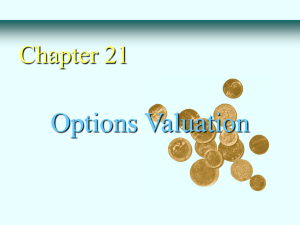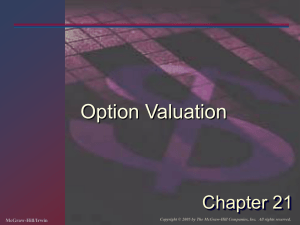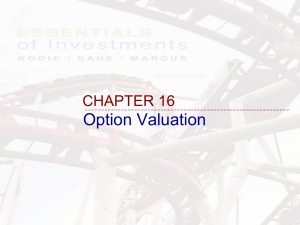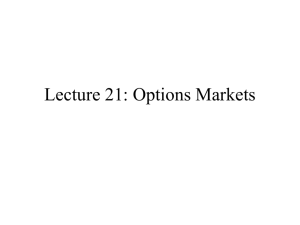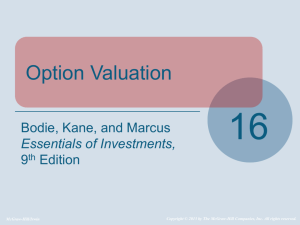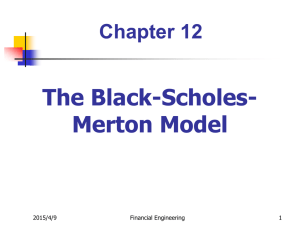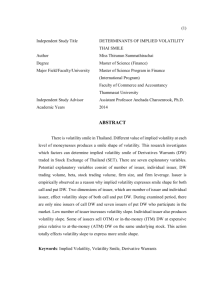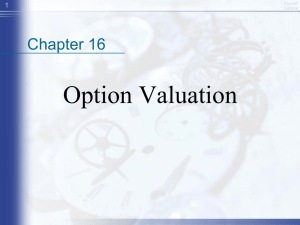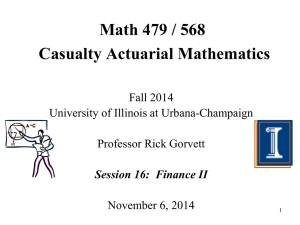Chap021 - revised
advertisement
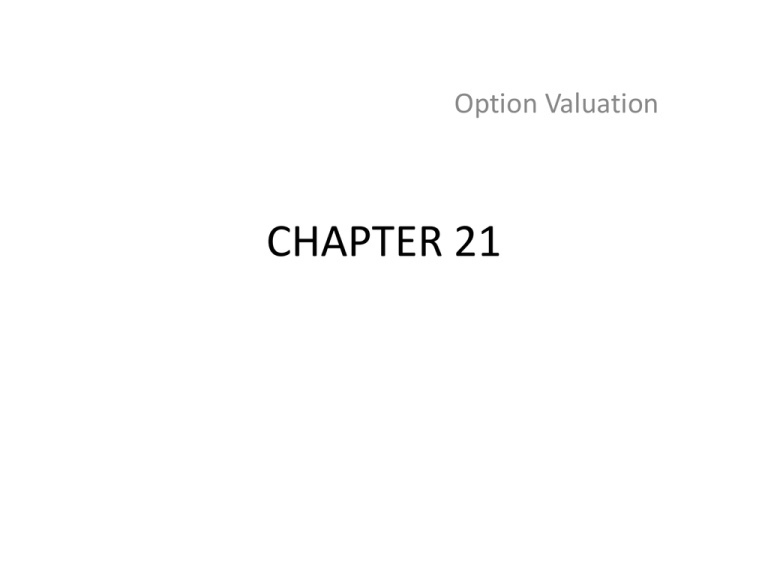
Option Valuation CHAPTER 21 Option Values • Intrinsic value - profit that could be made if the option was immediately exercised – Call: stock price - exercise price – Put: exercise price - stock price • Time value - the difference between the option price and the intrinsic value Figure 21.1 Call Option Value before Expiration Table 21.1 Determinants of Call Option Values Binomial Option Pricing: Text Example 120 100 10 C 90 Stock Price 0 Call Option Value X = 110 Binomial Option Pricing: Text Example Continued Alternative Portfolio Buy 1 share of stock at $100 Borrow $81.82 (10% Rate) 18.18 Net outlay $18.18 Payoff Value of Stock 90 120 Repay loan - 90 - 90 Net Payoff 0 30 30 0 Payoff Structure is exactly 3 times the Call Binomial Option Pricing: Text Example Continued 30 30 18.18 3C 0 3C = $18.18 C = $6.06 0 Replication of Payoffs and Option Values Alternative Portfolio - one share of stock and 3 calls written (X = 110) Portfolio is perfectly hedged Stock Value 90 120 Call Obligation 0 -30 Net payoff 90 90 Hence 100 - 3C = 90/(1 + rf) = 90/(1.1) = 81.82 3C = 100 – 81.82 = 18.18 Thus C = 6.06 Hedge Ratio (H) Number of stocks per option (H) H = (C+ - C-)/(S+ - S-) = (10 – 0)/(120 – 90) =1/3 Number of options per stock = 1/H = 3 Generalizing the Two-State Approach Assume that we can break the year into two sixmonth segments In each six-month segment the stock could increase by 10% or decrease by 5% Assume the stock is initially selling at 100 Possible outcomes: Increase by 10% twice Decrease by 5% twice Increase once and decrease once (2 paths) Generalizing the Two-State Approach Continued 121 110 104.50 100 95 90.25 Expanding to Consider Three Intervals • Assume that we can break the year into three intervals • For each interval the stock could increase by 5% or decrease by 3% • Assume the stock is initially selling at 100 Expanding to Consider Three Intervals Continued S+++ S++ S++- S+ S+- S S+-S- S-S--- Possible Outcomes with Three Intervals Event Probability Final Stock Price 3 up 1/8 100 (1.05)3 =115.76 2 up 1 down 3/8 100 (1.05)2 (.97) =106.94 1 up 2 down 3/8 100 (1.05) (.97)2 = 98.79 3 down 1/8 100 (.97)3 = 91.27 Figure 21.5 Probability Distributions Black-Scholes Option Valuation Co = SoN(d1) - Xe-rTN(d2) d1 = [ln(So/X) + (r + 2/2)T] / (T1/2) d2 = d1 + (T1/2) where Co = Current call option value So = Current stock price N(d) = probability that a random draw from a normal distribution will be less than d Black-Scholes Option Valuation Continued X = Exercise price e = 2.71828, the base of the natural log r = Risk-free interest rate (annualizes continuously compounded with the same maturity as the option) T = time to maturity of the option in years ln = Natural log function Standard deviation of annualized cont. compounded rate of return on the stock Figure 21.6 A Standard Normal Curve Call Option Example So = 100 X = 95 r = .10 T = .25 (quarter) = .50 d1 = [ln(100/95) + (.10+(5 2/2))(0.25)]/(5 .251/2) = .43 d2 = .43 + ((5.251/2) = .18 Probabilities from Normal Distribution N (.43) = .6664 Table 21.2 d N(d) .42 .6628 .43 .6664 Interpolation .44 .6700 Probabilities from Normal Distribution Continued N (.18) = .5714 Table 21.2 d N(d) .16 .5636 .18 .5714 .20 .5793 Table 21.2 Cumulative Normal Distribution Call Option Value Co = SoN(d1) - Xe-rTN(d2) Co = 100 X .6664 - 95 e- .10 X .25 X .5714 Co = 13.70 Implied Volatility Using Black-Scholes and the actual price of the option, solve for volatility. Is the implied volatility consistent with the stock? Spreadsheet 21.1 Spreadsheet to Calculate BlackScholes Option Values Figure 21.7 Using Goal Seek to Find Implied Volatility Figure 21.8 Implied Volatility of the S&P 500 (VIX Index) Black-Scholes Model with Dividends • The call option formula applies to stocks that pay dividends • One approach is to replace the stock price with a dividend adjusted stock price Replace S0 with S0 - PV (Dividends) Put Value Using Black-Scholes P = Xe-rT [1-N(d2)] - S0 [1-N(d1)] Using the sample call data S = 100 r = .10 X = 95 g = .5 T = .25 95e-10x.25(1-.5714)-100(1-.6664) = 6.35 Put Option Valuation: Using Put-Call Parity P = C + PV (X) - So = C + Xe-rT - So Using the example data C = 13.70 X = 95 S = 100 r = .10 T = .25 P = 13.70 + 95 e -.10 X .25 - 100 P = 6.35 Using the Black-Scholes Formula Hedging: Hedge ratio or delta The number of stocks required to hedge against the price risk of holding one option Call = N (d1) Put = N (d1) - 1 Option Elasticity Percentage change in the option’s value given a 1% change in the value of the underlying stock Figure 21.9 Call Option Value and Hedge Ratio Portfolio Insurance • Buying Puts - results in downside protection with unlimited upside potential • Limitations – Tracking errors if indexes are used for the puts – Maturity of puts may be too short – Hedge ratios or deltas change as stock values change Figure 21.10 Profit on a Protective Put Strategy Figure 21.11 Hedge Ratios Change as the Stock Price Fluctuates Figure 21.12 S&P 500 Cash-to-Futures Spread in Points at 15 Minute Intervals Hedging On Mispriced Options Option value is positively related to volatility: • If an investor believes that the volatility that is implied in an option’s price is too low, a profitable trade is possible • Profit must be hedged against a decline in the value of the stock • Performance depends on option price relative to the implied volatility Hedging and Delta The appropriate hedge will depend on the delta Recall the delta is the change in the value of the option relative to the change in the value of the stock Delta = Change in the value of the option Change of the value of the stock Mispriced Option: Text Example Implied volatility = 33% Investor believes volatility should = 35% Option maturity = 60 days Put price P = $4.495 Exercise price and stock price = $90 Risk-free rate r = 4% Delta = -.453 Table 21.3 Profit on a Hedged Put Portfolio Table 21.4 Profits on Delta-Neutral Options Portfolio Figure 21.13 Implied Volatility of the S&P 500 Index as a Function of Exercise Price
